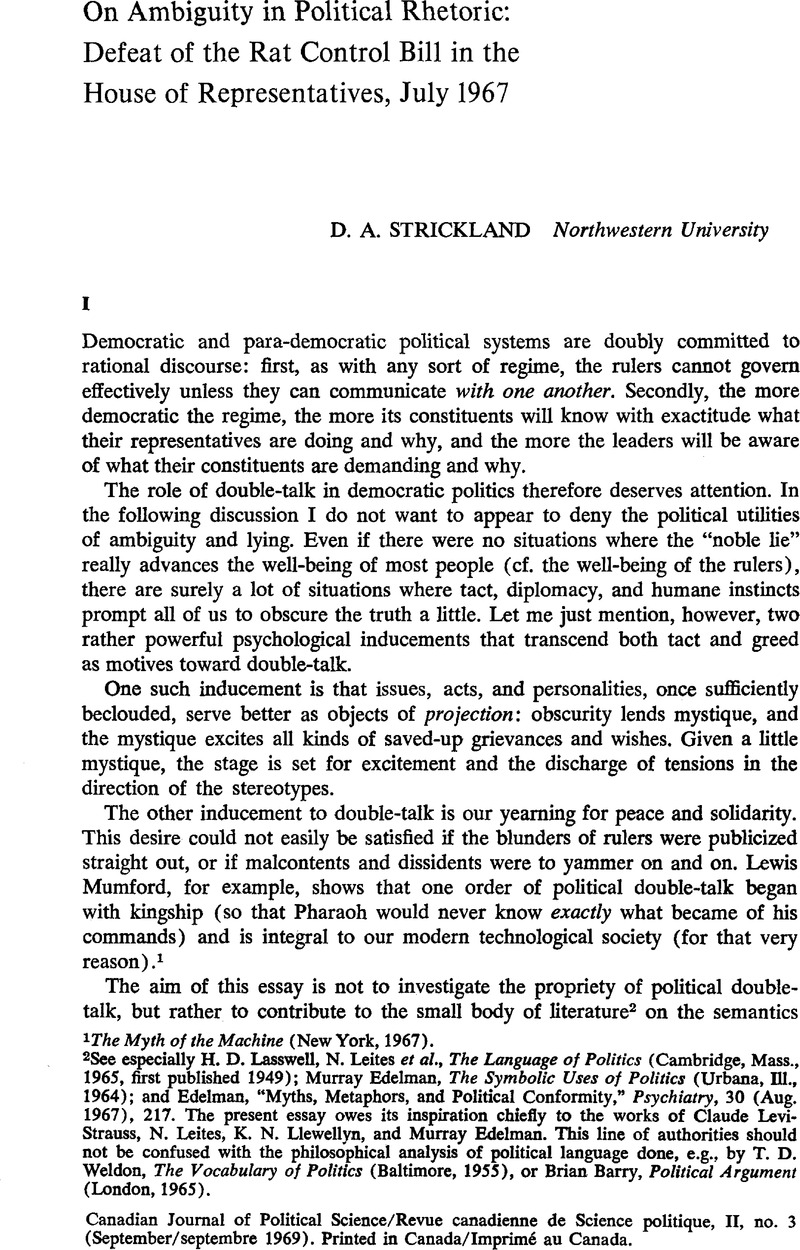Article contents
On Ambiguity in Political Rhetoric: Defeat of the Rat Control Bill in the House of Representatives, July 1967
Published online by Cambridge University Press: 10 November 2009
Abstract

- Type
- Articles
- Information
- Canadian Journal of Political Science/Revue canadienne de science politique , Volume 2 , Issue 3 , September 1969 , pp. 338 - 344
- Copyright
- Copyright © Canadian Political Science Association (l'Association canadienne de science politique) and/et la Société québécoise de science politique 1969
References
1 The Myth of the Machine (New York, 1967).
2 See especially Lasswell, H. D., Leites, N.et al., The Language of Politics (Cambridge, Mass., 1965Google Scholar, first published 1949); Edelman, Murray, The Symbolic Uses of Politics (Urbana, Ill., 1964)Google Scholar; and Edelman, , “Myths, Metaphors, and Political Conformity,” Psychiatry, 30 (Aug. 1967), 217.CrossRefGoogle ScholarPubMed The present essay owes its inspiration chiefly to the works of Claude Levi-Strauss, N. Leites, K. N. Llewellyn, and Murray Edelman. This line of authorities should not be confused with the philosophical analysis of political language done, e.g., by Weldon, T. D., The Vocabulary of Politics (Baltimore, 1955)Google Scholar, or Barry, Brian, Political Argument (London, 1965).Google Scholar
Canadian Journal of Political Science/Revue canadienne de Science politique, II, no. 3 (September/septembre 1969). Printed in Canada/Imprimé au Canada.
3 See, for example, Wender, P., “Communicative Unclarity: Some Comments on the Rhetoric of Confusion,” Psychiatry, 30 (Nov. 1967), 332CrossRefGoogle ScholarPubMed, and bibliography thereto.
4 For an interesting and careful analysis of types of ambiguity, see Empson, William, Seven Types of Ambiguity (London, 1963).Google Scholar Empson's approach, derived from the contemplation of literary materials, is not followed here because it is too precise for the quality of my data and because it does not account for obfuscation and the deteriorative effects of ambiguity in the manner that I want to call attention to that phenomenon.
5 H.R. 11000. The transcript of the debate is to be found in the Congressional Record for July 20, 1967.
6 The aim of the bill, H.R. 11000, was to authorize the appropriation of $20 million for fiscal years 1968 and 1969 as a program of grants to local governments for the extermination and control of rats. The House bill was defeated by a vote of 207–176 on July 20, 1967, just three days before the Detroit riots. The House reconsidered the bill later that summer and passed it on September 21 by a vote of 227–173.
7 For lack of resources, no validation test was performed in this exploratory study.
8 That is, a clause with one subject and two verbs would be counted twice.
9 Tests of significance were not run on these frequencies because the quality of such ordinal data, in advance of establishing its validity at the hands of more than one coder, does not warrant the testing for significance. The line of reasoning here employed may be found in D. A. Strickland and P. R. Kress, “Tests of Significance in Political Analysis,” in M. Haas, ed., Statistical and Quantitative Methods (Evanston, forthcoming).
10 See, for instance, Iklé, Fred Charles, How Nations Negotiate (New York, 1964).Google Scholar
- 1
- Cited by




